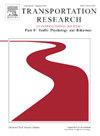Never being aggressive is important: A nationally representative survey of aggressive driving in Australia
IF 3.5
2区 工程技术
Q1 PSYCHOLOGY, APPLIED
Transportation Research Part F-Traffic Psychology and Behaviour
Pub Date : 2025-05-29
DOI:10.1016/j.trf.2025.05.023
引用次数: 0
Abstract
The Driving Anger Expression Inventory (DAX; Deffenbacher et al., 2002) is an established tool to measure the frequency of different types of aggressive driving (verbal, personal physical and aggressive use of the vehicle) as well as constructive responses to anger. This study assessed the applicability of DAX on a representative sample of 2,108 drivers from Australia (men = 49.8 %, women = 49.7 %, non-binary/gender-diverse = 0.05 %), ranging in age from 18 to 95 years (M = 46.5; SD = 17.8). Drivers completed an online survey comprising demographic information and the 15-item DAX. Importantly, the scale used in this study sought frequency responses across 5 categories (never, almost never, occasionally, often or almost always); whereas previous applications have not used a never response. Confirmatory Factor Analysis (CFA) showed that the four-factor structure was suitable for drivers in Australia. Multigroup CFA confirmed DAX was invariant across age, gender and main purpose of driving (work or leisure). Aggression was higher for men compared to women; work drivers compared to leisure drivers; and, drivers aged 26 to 39 years compared to younger (aged 18 to 25 years) or older drivers (aged 40 to 64 and 65 + years). After controlling for age and annual kilometres driven, higher scores on DAX were associated with increased odds of having been in a crash or having received a traffic fine in the past 12 months. The findings demonstrate that DAX is a viable tool to measure aggressive driving in Australia which should be administered with a never option.
从不咄咄逼人很重要:澳大利亚一项具有全国代表性的咄咄逼人驾驶调查
驾驶愤怒表达量表;defenbacher等人,2002)是一种已建立的工具,用于测量不同类型的攻击性驾驶(言语,个人身体和攻击性使用车辆)以及对愤怒的建设性反应的频率。本研究评估了DAX在澳大利亚2108名司机的代表性样本中的适用性(男性= 49.8%,女性= 49.7%,非二元/性别多样化= 0.05%),年龄从18岁到95岁不等(M = 46.5;sd = 17.8)。司机们完成了一项在线调查,包括人口统计信息和15项DAX指数。重要的是,本研究中使用的量表寻求5类(从不,几乎从不,偶尔,经常或几乎总是)的频率反应;而以前的应用程序没有使用never响应。验证性因子分析(CFA)表明,四因素结构适合澳大利亚驾驶员。多组CFA证实DAX在年龄、性别和主要驾驶目的(工作或休闲)之间是不变的。男性的攻击性高于女性;工作司机与休闲司机的比较;此外,26至39岁的司机与年龄较小的(18至25岁)或年龄较大的司机(40至64岁和65岁以上)相比。在控制了年龄和年驾驶公里数之后,DAX指数得分越高的人在过去12个月内发生车祸或收到交通罚款的几率越高。研究结果表明,DAX是一个可行的工具来衡量侵略性驾驶在澳大利亚,应该管理与永不选项。
本文章由计算机程序翻译,如有差异,请以英文原文为准。
求助全文
约1分钟内获得全文
求助全文
来源期刊
CiteScore
7.60
自引率
14.60%
发文量
239
审稿时长
71 days
期刊介绍:
Transportation Research Part F: Traffic Psychology and Behaviour focuses on the behavioural and psychological aspects of traffic and transport. The aim of the journal is to enhance theory development, improve the quality of empirical studies and to stimulate the application of research findings in practice. TRF provides a focus and a means of communication for the considerable amount of research activities that are now being carried out in this field. The journal provides a forum for transportation researchers, psychologists, ergonomists, engineers and policy-makers with an interest in traffic and transport psychology.

 求助内容:
求助内容: 应助结果提醒方式:
应助结果提醒方式:


